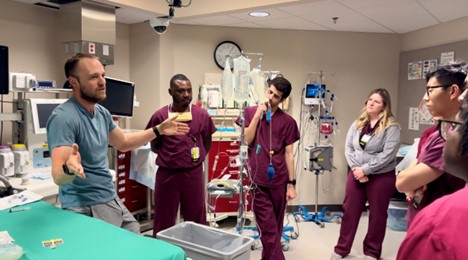
Advanced Clinical Medicine Rotation
We have always had a very active orientation program for our new trainees, and this program will be redesigned for this upcoming year to further improve the intern year experience, provide more individualized orientation, and introduce interns to the operating room even earlier! Going forward, interns will spend three months on the Advanced Clinical Medicine (ACM) rotation during the second half of intern year. Half of the intern class will rotate on ACM from January through March, while the other half will rotate from April through June.
The ACM rotation incorporates lectures, workshops, case discussions, and simulations to provide the foundation for the upcoming clinical anesthesia experience. During the Anesthesia orientation block, interns learn to setup the OR, check out the anesthesia machine, draw up medications, complete a focused anesthesia H&P, obtain patient consent for anesthesia, start IVs, intubate, complete electronic operative anesthesia records, communicate necessary information for transition of care to another provider, and conduct a basic anesthetic from beginning to end.
In addition to didactics and simulations, interns also become introduced to operating room anesthesia management with direct patient care experience. Early in the rotation, anesthesia interns will have days assigned to the OR while paired with a more senior resident. Later in the rotation, two interns will be paired up to work in the same OR with a single faculty member who has no other responsibility but to work with the orienting trainees. By the end of the rotation, interns will be able to run simple anesthetic cases from start to finish by themselves under the supervision of teaching faculty.
The ABA only allows one month of Anesthesia during the Clinical Base Year (CBY)—a collection of fundamental rotations that are typically completed during intern year. However, these rotations do not have to be completed during intern year. To allow for this new, extended orientation program, two CBY rotations will take place during the CA-1 year for each resident, most likely early in the year.
Teaching in the OR
We have about 80 faculty–which translates into 80 different teaching styles. Some give mini talks, some ask a lot of questions, some give practice oral boards, some discuss various topics or journal articles. Some never stop teaching; others need to be prompted by the residents. Some are tougher than others. But all of them want to teach–and the department places great emphasis on clinical teaching.
There are multiple systems in place for residents to provide feedback to faculty. This feedback provides input for faculty to adjust their practices and plays a role in the annual review and promotions process. When concerning feedback arises, the education leaders can help these faculty to determine a plan for improving their teaching skills.